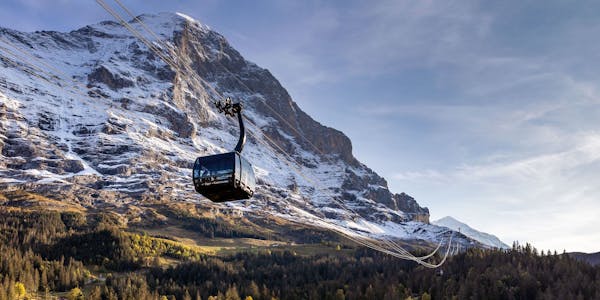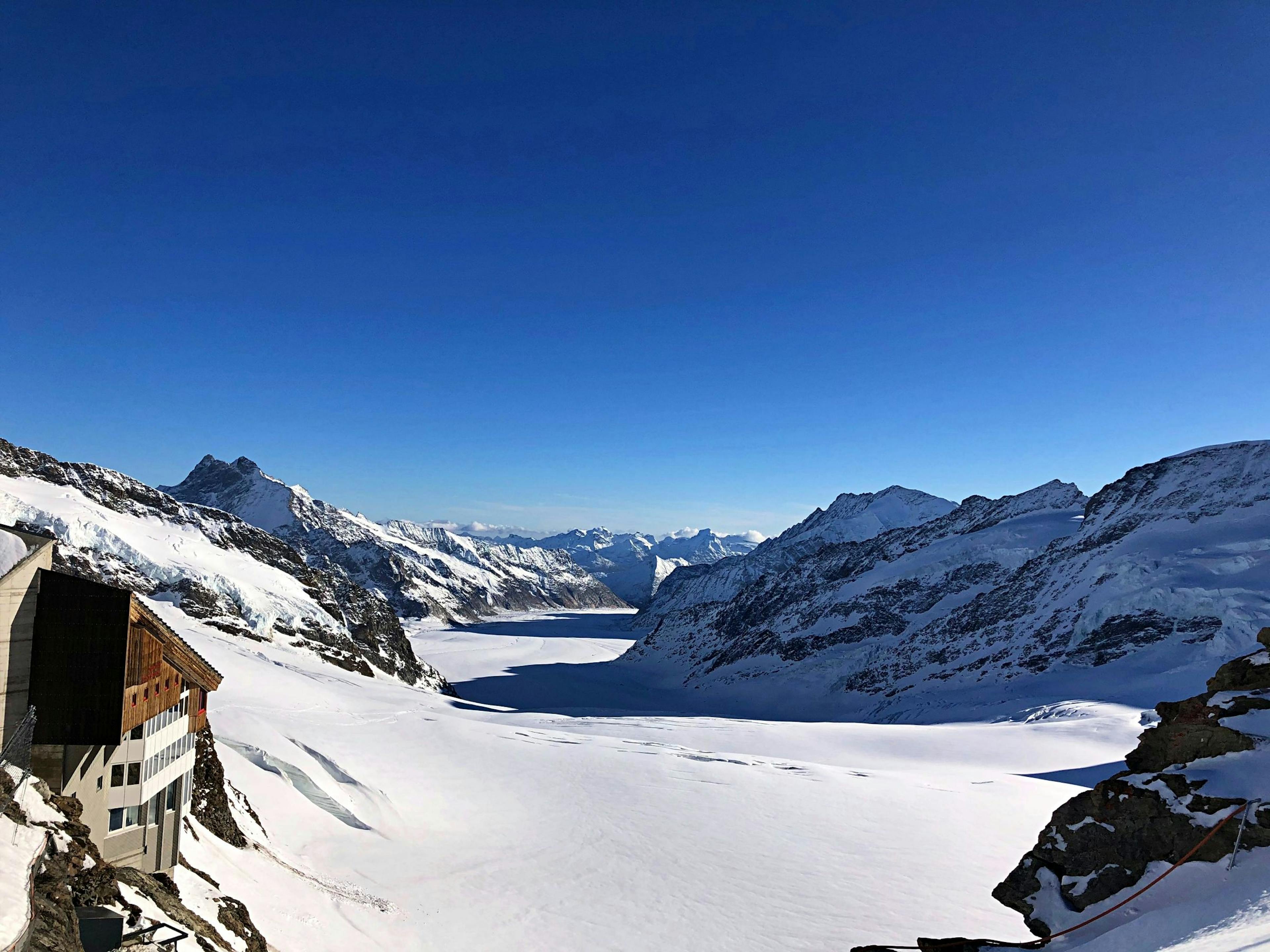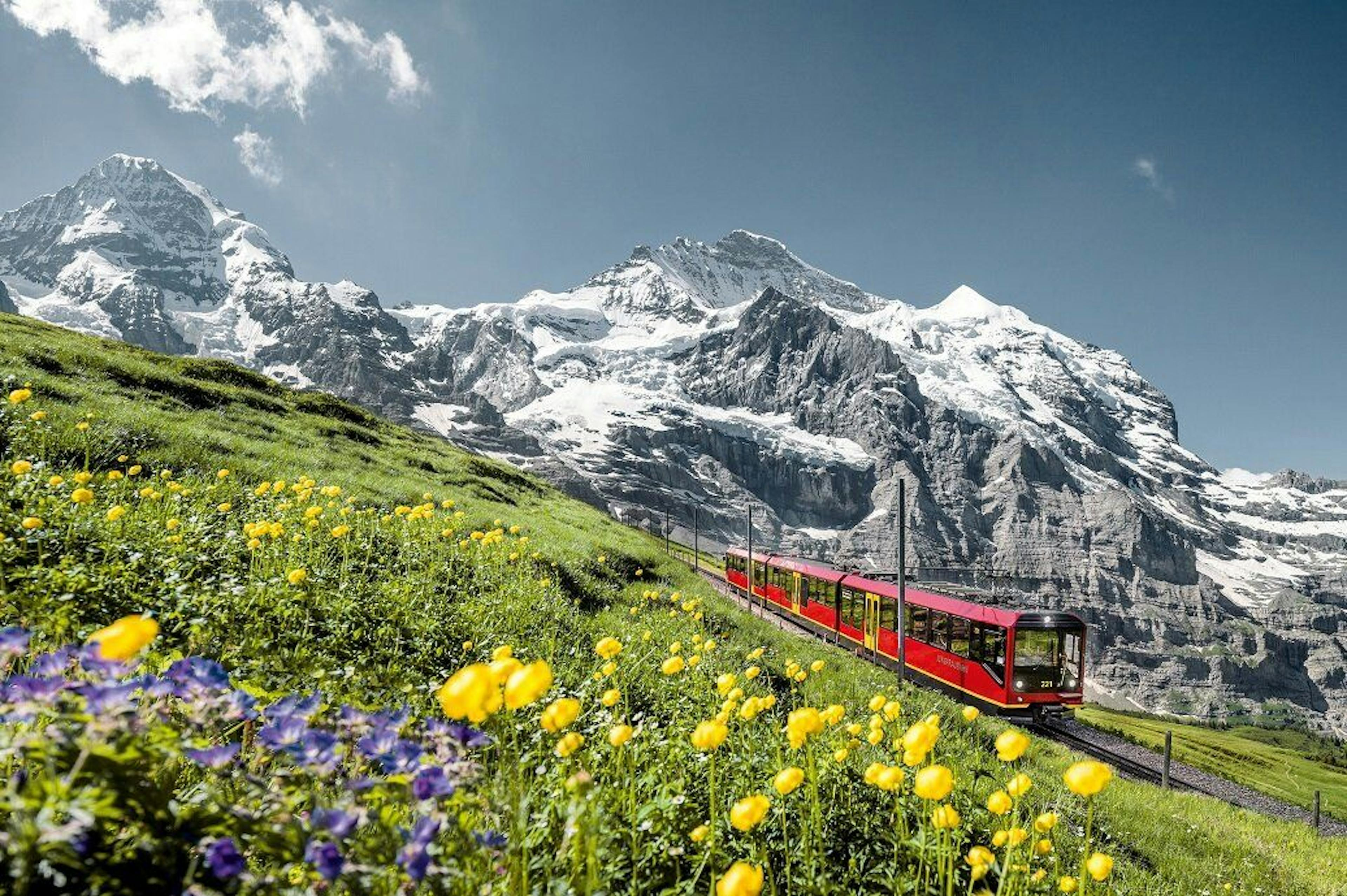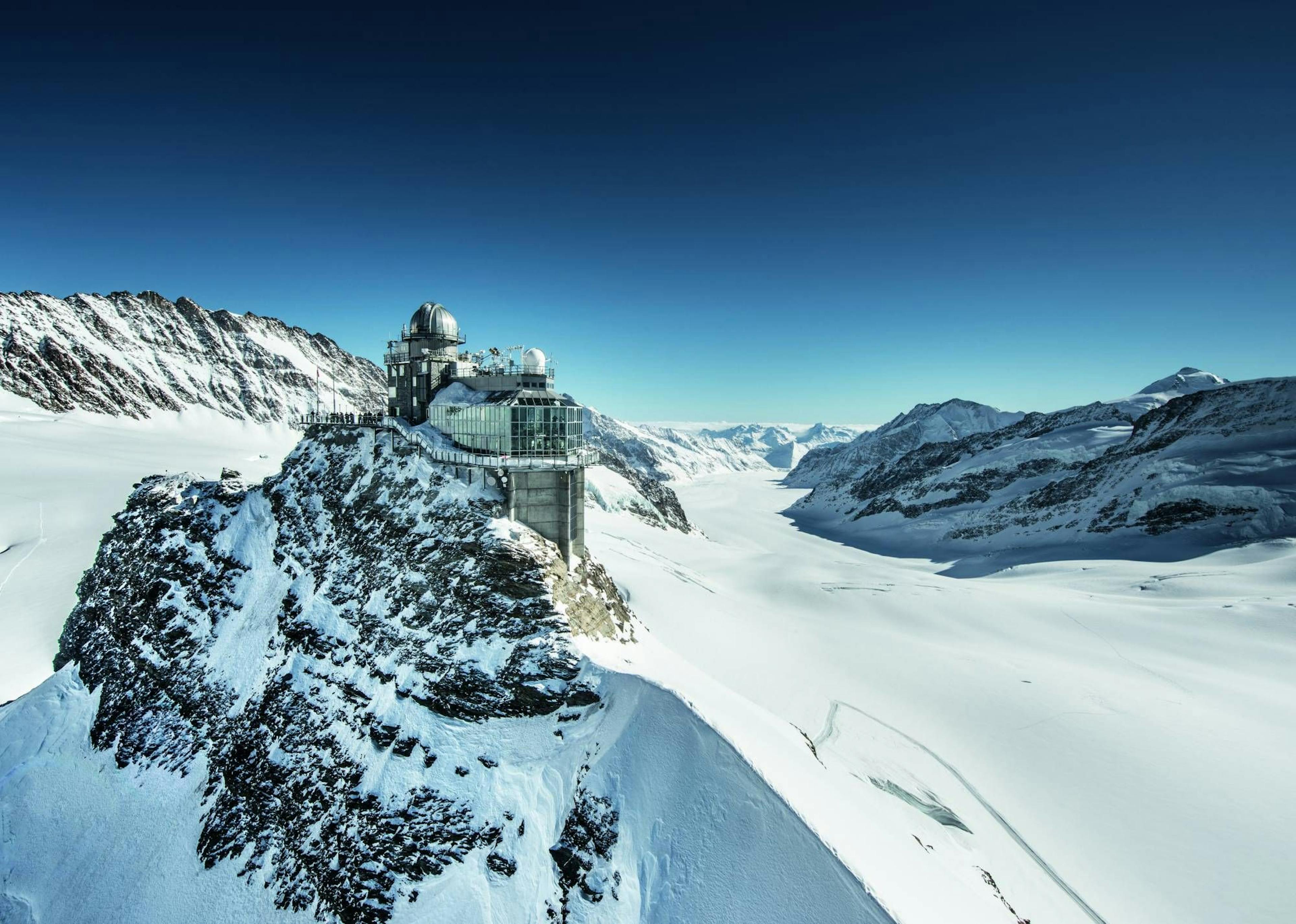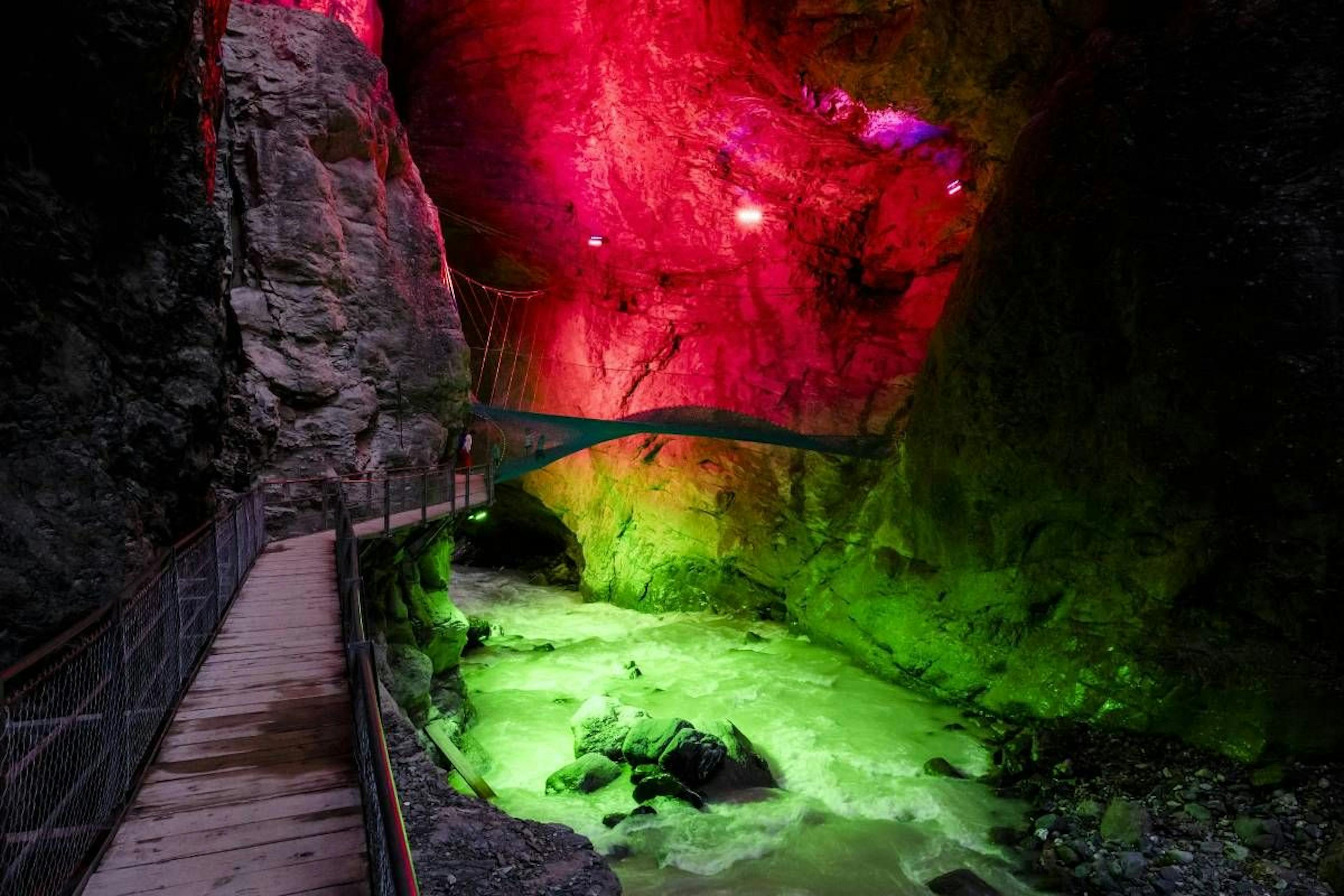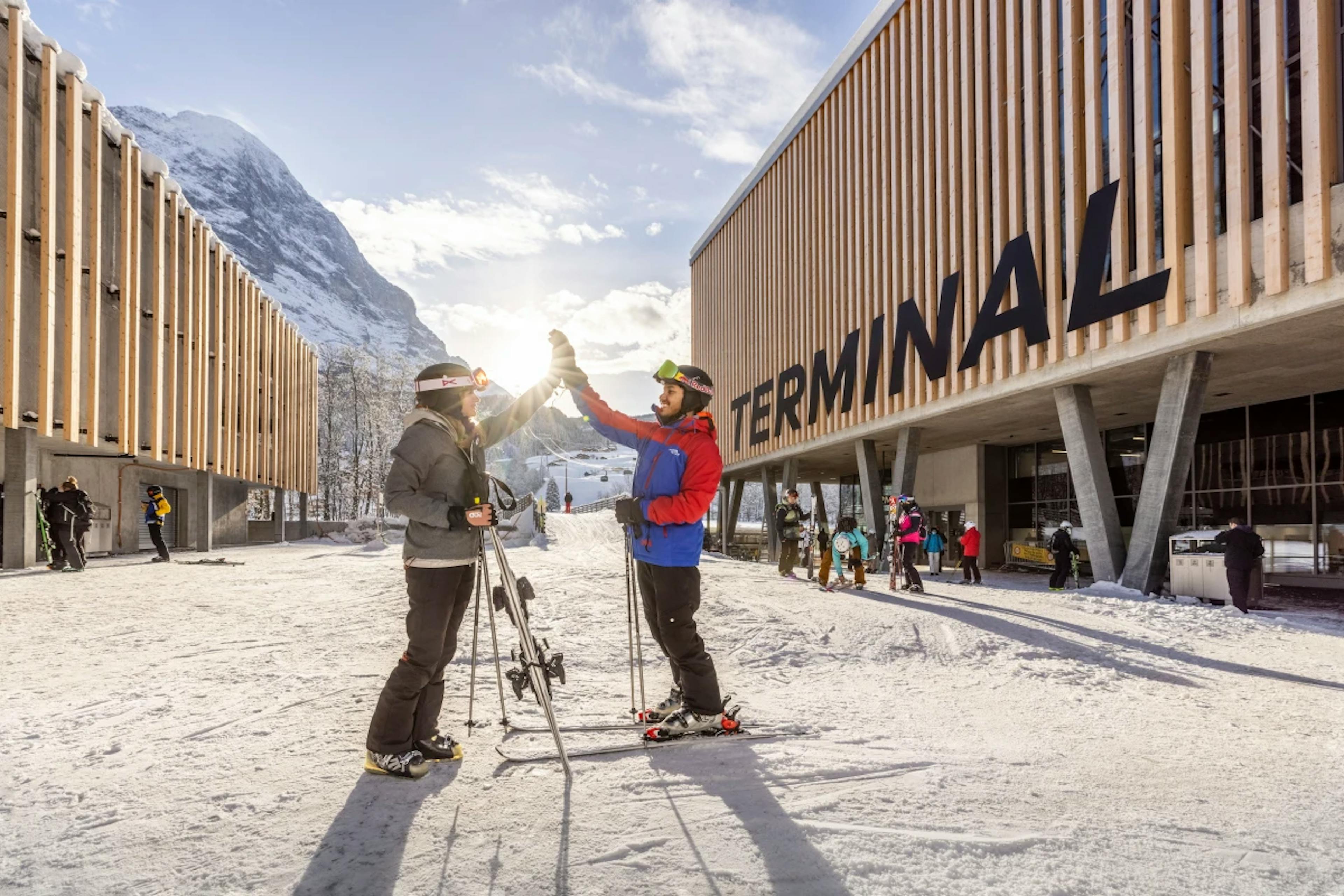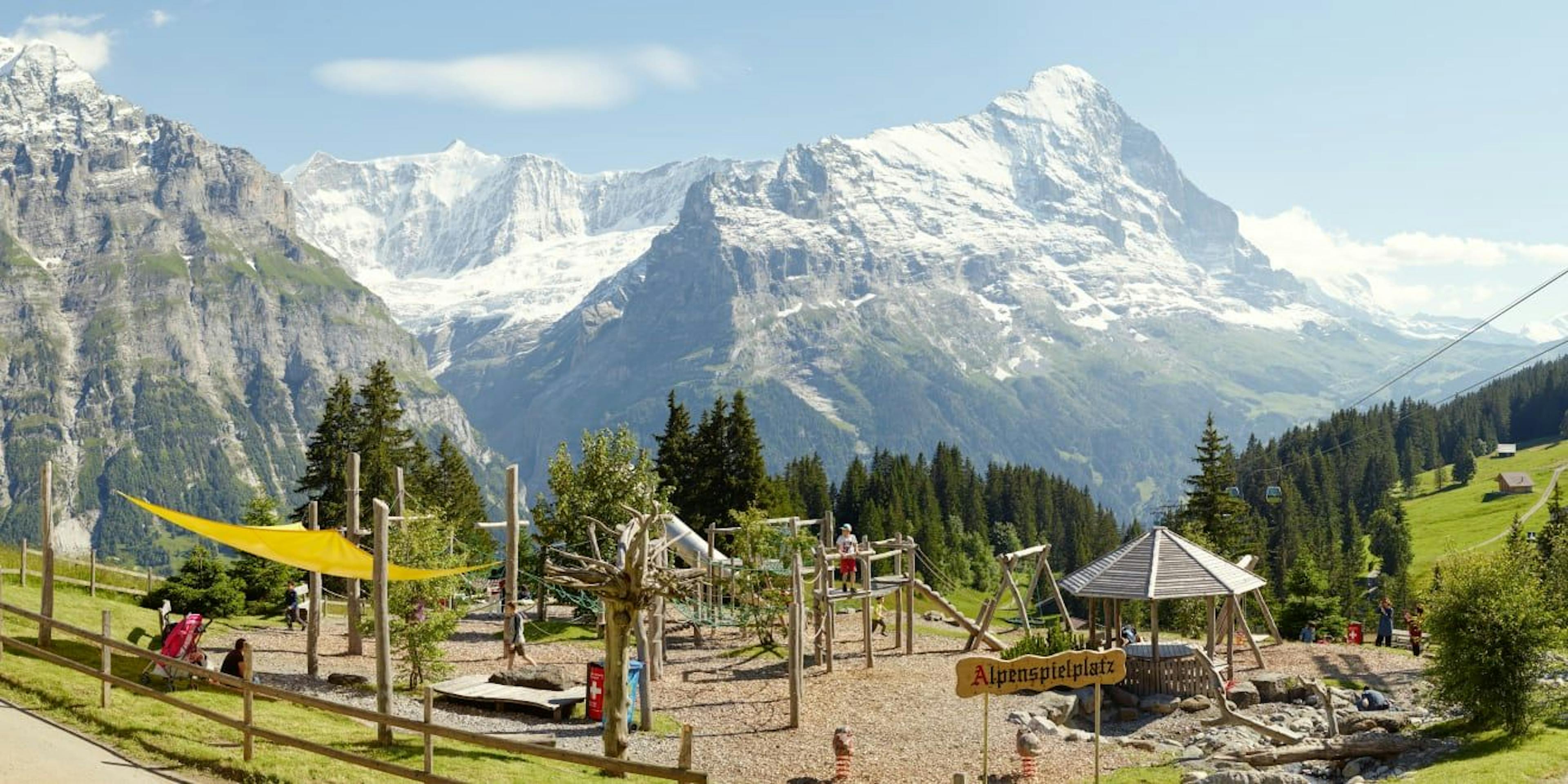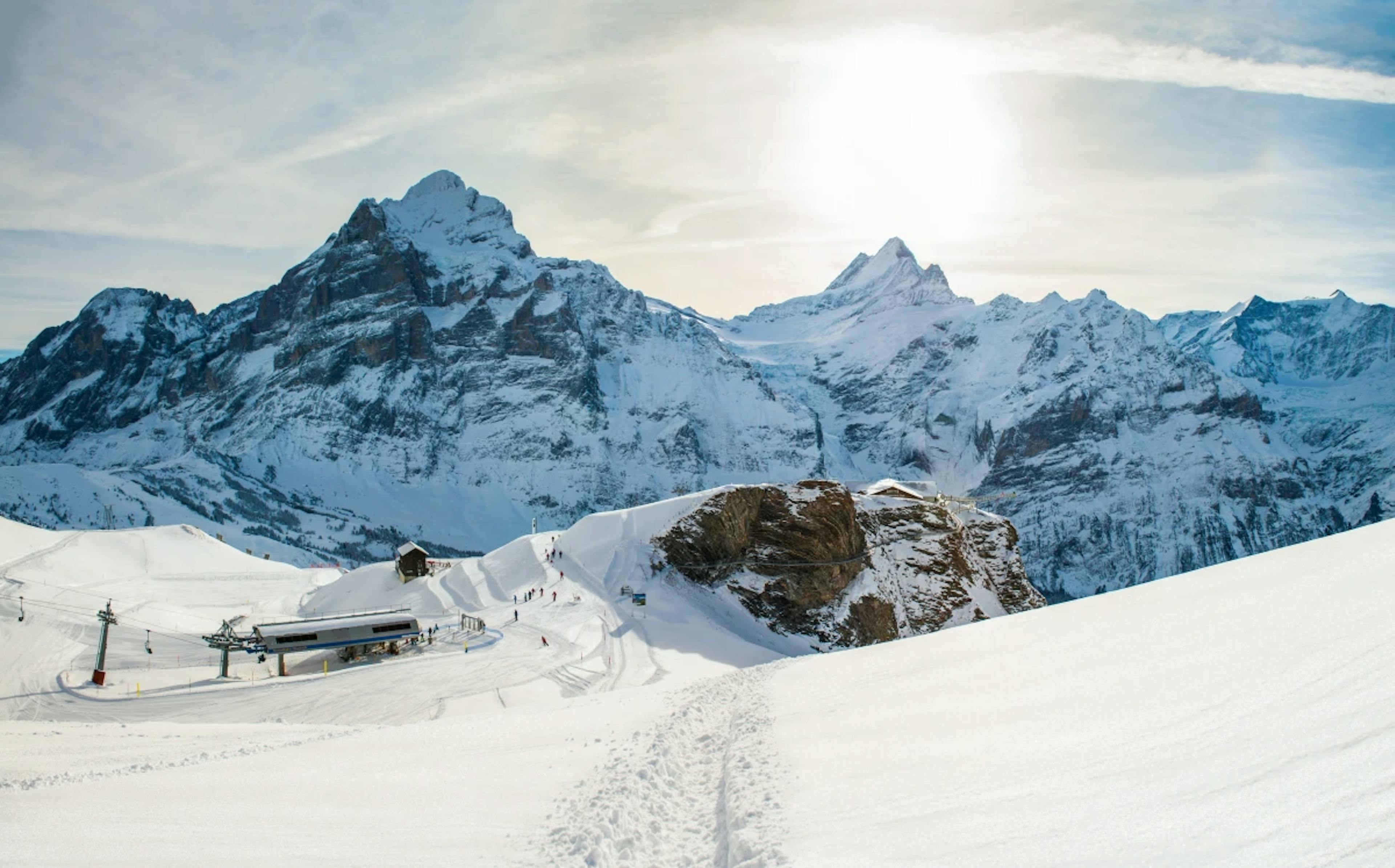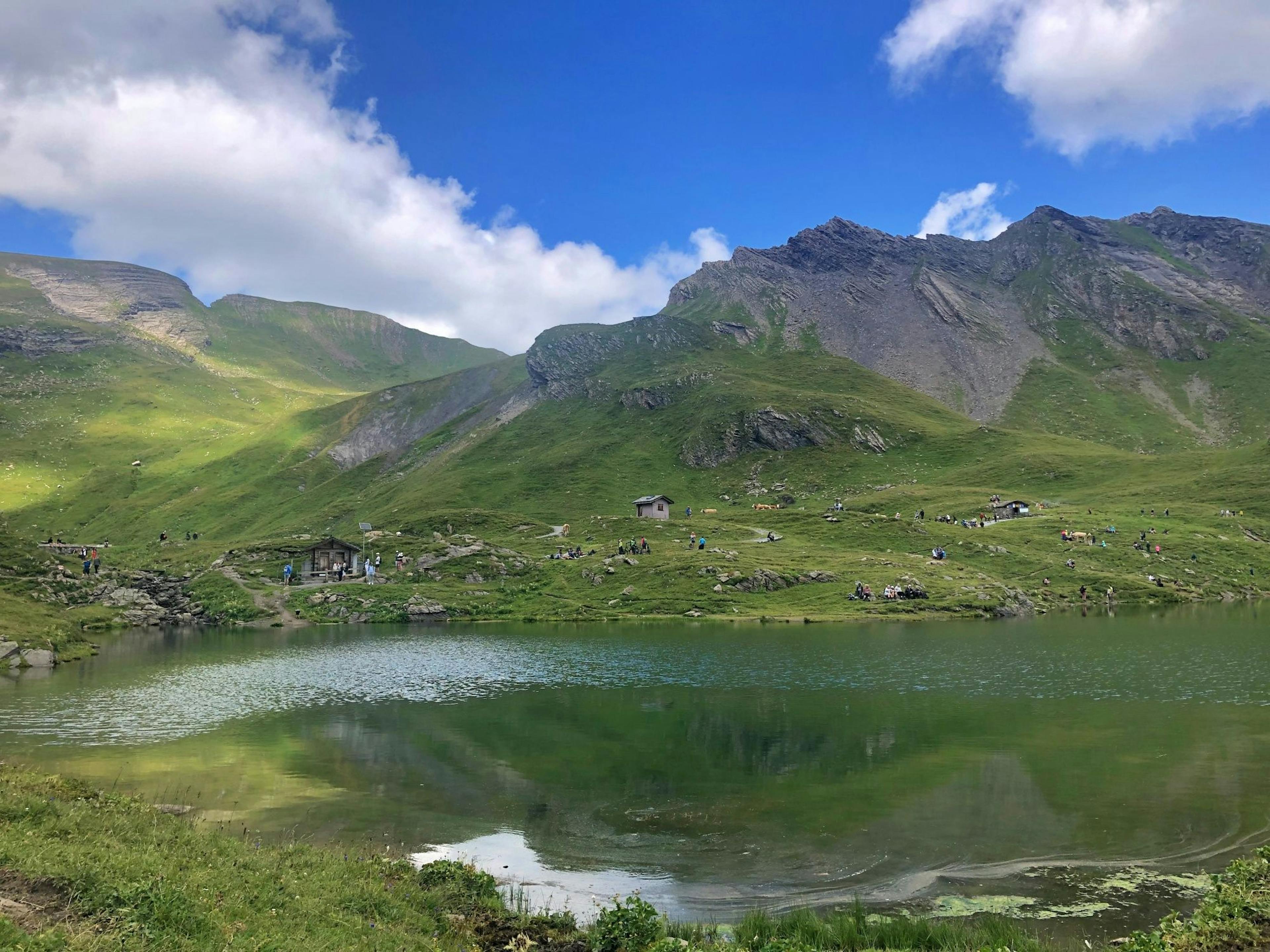
"Top of Europe" is the name given to the railroad station, which is the terminus of the railroad to the Jungfraujoch inside the Sphinx at 3454 m above sea level.
12 Highlights on the Jungfraujoch
- At 3571 m above sea level, there is a viewing platform around a glazed viewing hall. Next to it is the Sphinx Observatory with an astronomical dome and weather observation station.
- At 22 km long, the Aletsch Glacier is the largest glacier in Europe. It stretches southwards from the Jungfraujoch and covers an area of around 80 km².
- A 1000 m² labyrinth of winding ice paths and caves runs beneath the Aletsch Glacier and can be visited.
- A 360-degree cinema below the Jungfraujoch shows the high alpine world all around. The tour is 250 m long and contains adventure niches at intervals.
- The climate on the Jungfraujoch is extreme and unpredictable. Even in summer, icing, avalanches and strong winds can occur.
- One-day and multi-day glacier trekking tours can be undertaken with mountain guides in summer.
- Ice caves are located on the edge of the glacier below the Jungfraujoch. They can be visited on guided glacier hikes from Moosfluh or Bettmeralp.
- Helicopter flights to the Jungfraujoch offer a direct view of the 4158-metre-high summit of the Jungfrau, Mönch and Eiger.
- There is a snow fun park with Tyrolienne on the Jungfraujoch.
- Several restaurants and bars cater for guests on a self-service or à la carte basis.
- The Top of Europe flagship store extends over two floors.
Even the ride on the Jungfrau Railway is a very special experience. The Jungfraujoch has been accessible via the Jungfrau Railway from the Kleine Scheidegg valley station since 1912. The journey takes 35 minutes. Guided glacier hikes are possible from the Jungfraujoch, revealing a very beautiful and extraordinary glacier world. Even those who do not dare to do so can experience the unique glacier world from the glacier platform.
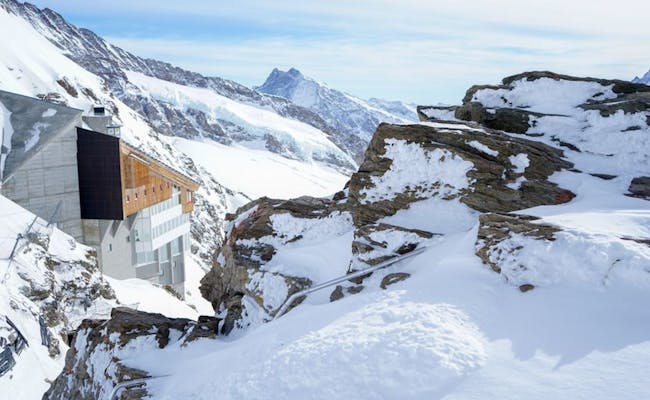 Top of Europe (Foto: Jungfrau Region)
Top of Europe (Foto: Jungfrau Region)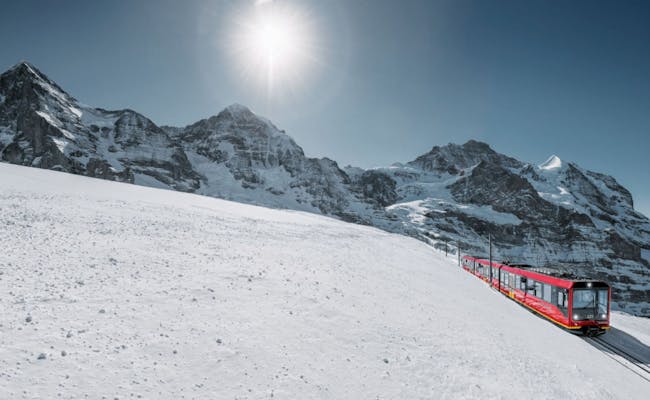 Jungfraubahn (Foto: Jungfraubahnen)
Jungfraubahn (Foto: Jungfraubahnen)Sights at the Jungfraujoch
The Jungfraujoch represents the transition between the peaks of the mountains Jungfrau and Mönch. It is located on the border of the two regions Bernese Oberland and Valais. The Jungfraujoch is part of the Unesco World Heritage "Swiss Alps Jungfrau-Aletsch".
A ride on the Jungfrau Railway up to the "Top of Europe" is already part of the experiences around the Joch. Viewing platforms on the Sphinx rock next to the observatory and above the Top of Europe train station offer an overview of the region and, in fine weather, beyond. Popular destinations for excursions are the Great Aletsch Glacier, the Ice Palace below it or the ice caves on the edge of the glacier.
Sightseeing attractions include:
- Sphinx Observatory with viewing platform
- The Jungfraujoch plateau: the glacier platform
- The Ice Palace under the Aletsch Glacier
- Alpine sensation at the Jungfraujoch
- The Great Aletsch Glacier at the Jungfraujoch
- Jungfrau Panorama
Sphinx Observatory with viewing platform
At the Jungfraujoch, the observatory of the same name stands on a rocky outcrop called Sphinx. It belongs to a foundation of Jungfraubahn Holding AG. In addition to an astronomical dome and a weather observation station, it consists of several laboratories, a workshop and two terraces that are used for scientific projects.
The 76 cm telescope in the dome is no longer used. The observatory handles various projects, including long-term projects. On the Jungfrau East Ridge, at an altitude of 3,700 meters, mainly climate and environmental measurements are carried out. A heated inlet system is installed on the roof. From the Jungfraujoch train station, the trail leads through a 560-meter tunnel through the ice, as well as a funicular that covers a 240-meter difference in altitude.
The weather station is the highest still permanently manned station in the world. The readings of about 25 weather elements are transmitted to the headquarters in Zurich every ten minutes. These facilities cannot be visited inside.
The Sphinx viewing platform
The Jungfraujoch viewing platform runs around the observatory. The Sphinx viewing platform is located at 3,571 meters above sea level. It offers a distant view over the Alps, reaching as far as the Vosges and the Black Forest in good visibility conditions. On the other side, a view over the Aletsch glacier is possible.
Since 1996, the observation hall has been glazed and terraces run around the observatory building. A 111-meter lift leads to the observatory, covering this distance in 25 seconds. Above the observation deck run taut steel cables. They form a Faraday cage and thus protect against lightning strikes, which can occur at this height even when the sky is blue.
The observation platform is open daily during the operating hours of the railroad.
The Jungfraujoch plateau: the glacier platform
Above the Ice Palace, visitors to the Jungfraujoch can access the plateau via direct paths. It is located at 3,451 meters.
There is snow and ice on the glacier platform, which is full of views, all year round. The viewing platform is used for views, photography and as a meeting point for guided treks across the Aletsch Glacier, ski tours and hikes. Events are also held here and in the run-up to Christmas a Christmas tree is erected, which is visited by Samichlous on 06 December and by the Christ Child on Christmas Eve.
From the station the path leads up through the tunnel system. Below the entrance to the Ice Palace, the path goes outside and slightly uphill to the plateau.
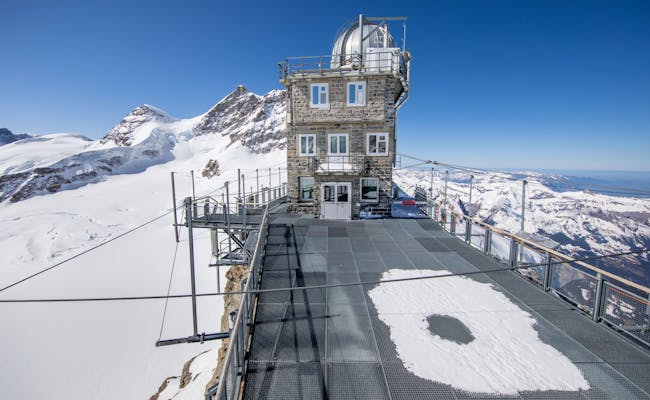 Sphinx Terrasse (Foto: Jungfraubahnen)
Sphinx Terrasse (Foto: Jungfraubahnen)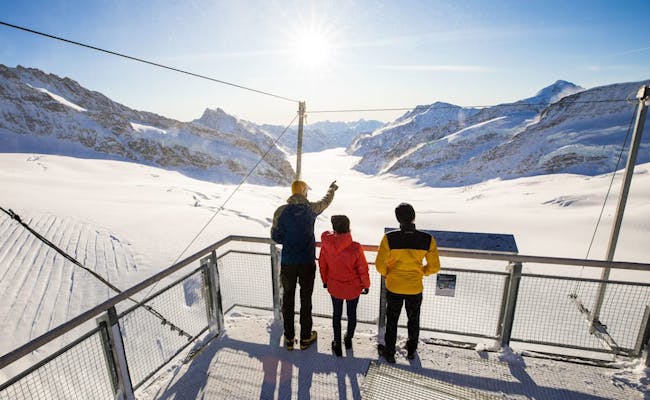 Sphinx Aussicht (Foto: Jungfraubahnen)
Sphinx Aussicht (Foto: Jungfraubahnen)Jungfraujoch Ice Palace under the Aletsch Glacier
The ICE gateway guides visitors from the Jungfraujoch down to the Ice Palace. In the 1930s, mountain guides created the passages and halls with saws and picks. They are located about twenty meters below the Aletsch Glacier
The labyrinth of winding ice paths with cave-like halls and rooms covers a total of 1,000 square meters. Today, works of art made of ice are exhibited here in niches next to the partially mirror-smooth passages. Eagles, bears, dogs, ibexes or penguins are among the works of art that an artist creates each year. Even "Charlie Chaplin and the kid", a scene from Chaplin's World Museum, has already been created in ice and exhibited here. The temperature of the ice palace must be constantly maintained at a temperature of -3°C. The vault and the ceilings have to be regularly reworked because of the evaporation of the visitors. There are railings in slippery places.
The Ice Palace is open daily from 7:30 am to 4:15 pm.
Just before the entrance to the Ice Palace, a view of the mountain interior is possible. From a bridge, at an altitude of 3,483 meters, it is possible to view a karst cave made visible by the construction of the tunnel.
Alpine sensation at the Jungfraujoch
Below the Jungfraujoch, a 250-meter tunnel depicts the beginnings of the Jungfrau Railway. The tunnel runs between the Ice Palace and the Sphinx Hall. Visitors experience the pioneering era of the railroad and the mountain in the multimedia display of Alpine Sensation, partly on moving walkways.
A film projection room is located in the Sphinx Hall. A 360-degree cinema shows the high alpine world around the Jungfraujoch. The adventure tour is 250 meters long and contains adventure niches at intervals
For example, the brothers Rudolf and Hieronymus Meyer from Aarau stand as Jungfrau first climbers. Two Valais mountain guides can also be seen: Alois Volken and Joseph Bortis. Original black and white photographs are accompanied by sounds of railroad construction. Thirty commemorative plaques tell of the victims of the Italian miners during the railroad development of the Jungfraujoch. The young men were no more than twenty years old. The Alpine Sensation covers 1,200 square meters and is open all year round.
The Great Aletsch Glacier at the Jungfraujoch
At the Jungfraujoch, the Aletsch Glacier begins to the south and, at twenty-two kilometers long, is the longest glacier in Europe. The ice masses cover an area of about 80 km². Glaciers consist of ice, firn on top and snow at the very top. Firn is older snow that has acquired a higher density through thawing and freezing. About one meter of firn is created from eight meters of new snow.
From the Jungfraujoch, the glacier leads to the Konkordiaplatz, which covers an area of 6 km². At this point four glaciers meet and flow together as the Great Aletsch Glacier further south. The firn depressions come largely from regions around 3,800 meters above sea level from mountains such as Jungfrau, Aletschhorn, Mönch, grosses Fischerhorn, Grünhorn, Kranzberg and Trugberg.
The four glaciers:
- The Grosse Aletschfirn flows from the west and has a width of 1.5 km and a length of 9 km up to the Konkordiaplatz.
- The seven-kilometer-long Jungfraufirn flows in from the northwest.
- The Ewigschneefäld comes from the north and flows in 8 km length and 1.2 km width.
- The Grüneggfirn joins it from the east.
The Great Aletsch Glacier is 900 meters thick and weighs about 27 billion tons. It moves about 200 meters per year at the Konkordiaplatz. Differing flow velocities within the glacier create stresses that lead to deep cracks.
Jungfraujoch Panorama
The Jungfrau Panorama film provides an all-round experience of the mountain world around the Jungfraujoch. Visitors get the feeling of flying through clouds, plunging into masses of snow or even sinking into crevasses of ice. The film is shown on all days as long as the mountain railroads are running.
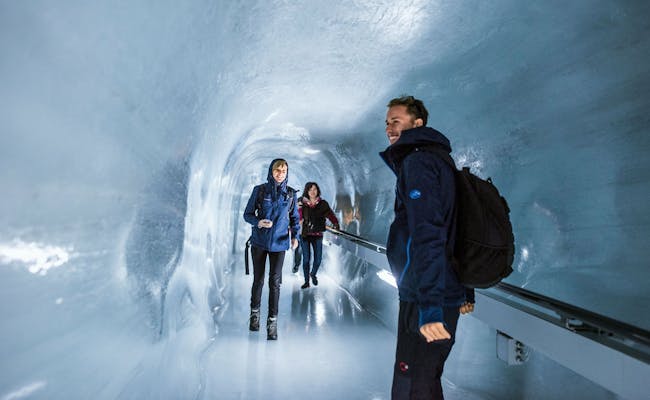 Eispalast (Foto: Jungfraubahnen)
Eispalast (Foto: Jungfraubahnen) Alpine Sensation (Foto: Jungfraubahnen)
Alpine Sensation (Foto: Jungfraubahnen)Ride with the Jungfrau Railway
The Joch has been accessible since 1912 via the Jungfraubahn, which has its valley station in Kleine Scheidegg. The Jungfrau Railway is an electric rack railroad. From Kleine Scheidegg to Jungfraujoch, the route of the railroad passes through Eiger and Mönch.
Seven kilometers of the total 9.34 kilometers that the railroad overcomes are in a tunnel. In the process, it climbs about 1,400 meters in altitude. Before reaching its terminus, the Jungfrau Railway stops at the Eiger Glacier (2,320 m) and Eismeer (3,158 m) stations. The terminus of the railroad to Jungfraujoch is located inside the Sphinx at 3,454 meters above sea level. Sphinx is the name given to a rocky knoll at the Jungfraujoch where the Sphinx Observatory is located. The trip takes 35 minutes.
Descending railroads stop for five minutes at a time at two observation windows, which were used to remove excavated material when the railroad was built. The railroad still runs on 1125 V three-phase current and therefore has two parallel contact lines. During the descent, the braking energy is fed back into the catenary as electrical energy.
 Station Eigergletscher (Foto: Jungfraubahnen)
Station Eigergletscher (Foto: Jungfraubahnen)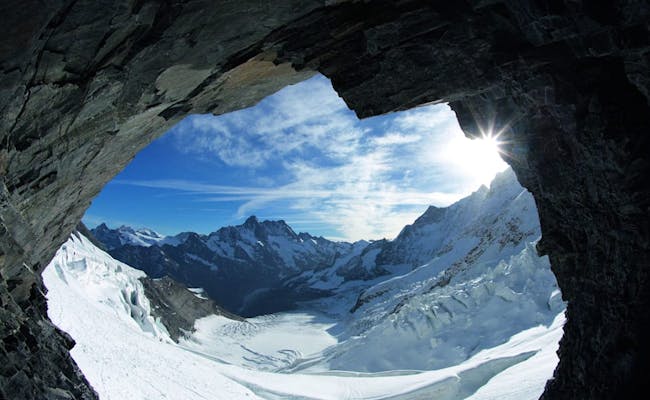 Sichtfenster Eismeer (Foto: Jungfraubahnen)
Sichtfenster Eismeer (Foto: Jungfraubahnen)Cable car Eiger Express from Grindelwald Terminal
From Grindelwald Terminal, the Eiger Express cuts the total travel time to Jungfraujoch in half compared to the rack railroad. At the Eiger glacier, you then board the rack railroad.
The Eiger Express is a three-cable circulating railroad with a length of 6483 meters. It overcomes 1391 meters in altitude.
Offer dei Swiss Activities:
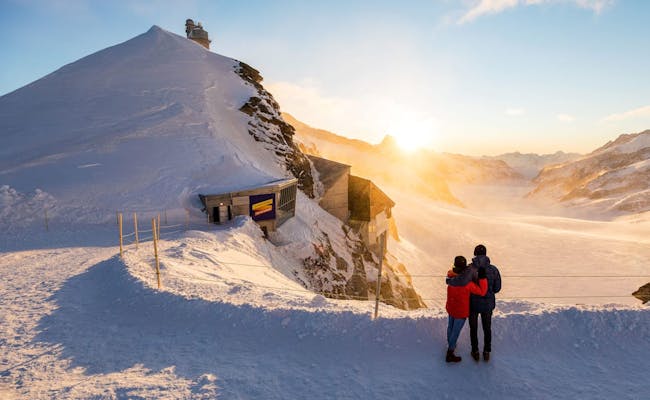 Sonnenaufgang (Foto: Jungfraubahnen)
Sonnenaufgang (Foto: Jungfraubahnen) Eiger Express innen (Foto: Jungfraubahnen)
Eiger Express innen (Foto: Jungfraubahnen)Activities on the Jungfraujoch
Numerous hikes and glacier trekking tours are undertaken in the region in summer with mountain guides. The weather is always unpredictable up here, but summer is certainly more suitable. Some activities can be carried out on the Jungfernjoch glacier all year round.
These include some of the summer hikes in good weather conditions. The shelters of the mountain huts are also open to alpinists in winter. Fuel is available and there are cooking facilities and showers. However, hikes and trekking tours across the glacier should only be undertaken by alpinists or with a mountain guide.
Even though these activities can be carried out all year round, the weather conditions on the Jungfraujoch must be taken into account.
The excursion destinations at the Top of Europe are also open to visitors all year round.
The activities primarily include
- Trekking and ski tours across the Aletsch Glacier
- Glacier hikes to the Konkordia hut
- Hike to the ice caves below the Jungfraujoch
- Hike from the Jungfraujoch to the Mönchsjochhütte
- Via ferrata on the Jungfraujoch
- Helicopter flight to the Jungfraujoch
- Snow fun park on the Jungfraujoch with Tyrolienne
- Snowkiting on the Jungfraujoch
Trekking and ski tours across the Aletsch Glacier
In summer, the Aletsch Glacier is used by mountaineering schools and private mountain guides for glacier trekking from the Jungfraujoch. These tours are also suitable for beginners with a normal level of fitness. They are trekking tours that involve five to six hours of walking in thinner air.
Glacier hikes on your own require a good knowledge of the technical and navigational challenges, as the conditions on the glacier can change dramatically in a very short time.
Ski tours on the Aletsch Glacier, for example, have the Lötschenlücke as their destination. High mountain tours to the Eiger, Jungfrau, Mönch and other peaks also start here.
Glacier hikes to the Konkordiahütte on the Jungfraujoch
Hikes from the Jungfraujoch across the glacier to the Konkordiahütte start at the Sphinxstollen of the Jungfraujoch. The Konkordiahütte consists of several buildings and belongs to the Swiss Alpine Club SAC.
Tours to the Konkordiahütte are carried out as one-day or multi-day hikes. They continue the following day, for example, to Riederalp or Märjelesee.
The Konkordiahütte stands at 2,850 meters above sea level, more than 150 meters above the Konkordiaplatz. The SAC gives these approaches to the hut:
Hike from Jungfraujoch to Konkordiahütte (4 hrs, 160 hm ascent, 760 hm descent):
From the Jungfraujoch (3,454m) the trail goes via the Sphinxstollen to the Jungfraufirn. Afterwards, a descent over two glacier depressions, one behind the other, leads down to a flatter terrain, where the Jungfraufirn meets the Ewigschneefäld. Then the moraine and the glacier stream are crossed. A gentle climb leads to the S foot of Grünegg and over a second moraine. Clearly visible metal stairs lead up to the hut. In summer, the path quickly becomes slippery due to snow melt. Temporary bridges make the paths passable in summer.
Ski tour from Jungfraujoch to Konkordiahütte (1-1.5 hrs, 150 hm ascent, 740 hm descent):
Via the Sphinxstollen, the trail leads to the Konkordiaplatz via the Jungfraufirn southeastward down, across the wide area to the eastern edge to the ski depot of the hut at the foot of the metal ladders.
Ski tour from Jungfraujoch via Ewigschneefäld to Konkordiahütte (1.5-2 hrs, 310 hm ascent, 900 hm descent):
Via the Sphinxstollen, head northeast along the winter hiking trail to the Oberen Mönchsjoch (3623 m). Via the Ewigschneefäld the descent leads down to the rock spur (point 3135). East of the glacier break (on the left) it goes down through a hollow to the Konkordiaplatz to the ski depot of the hut at the foot of the metal stairs.
The Konkordiahütte has 155 sleeping places and a shelter with 35 places. Overnight stays must be reserved in advance. The hut is closed from mid-September to mid-March. The winter room is located below the main hut in the Hasler hut and offers shelter and protection during the unattended period. A wood stove, beds, blankets, pillows, light as well as emergency provisions are available in the hut.
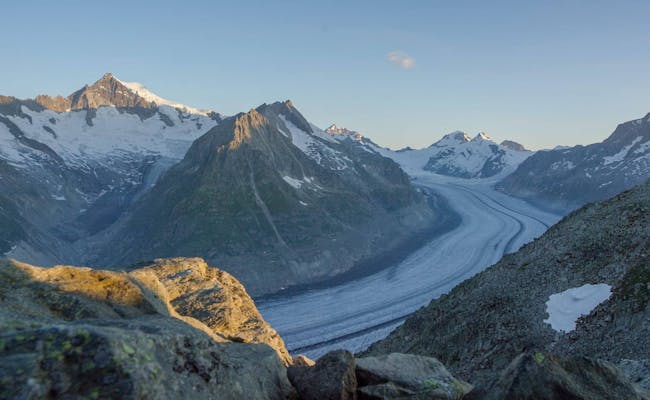 Aletschgletscher Mittelmoränen (Foto: Jungfraubahnen)
Aletschgletscher Mittelmoränen (Foto: Jungfraubahnen)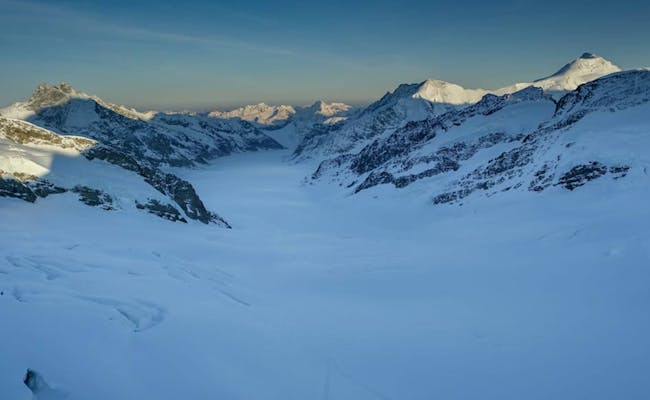 Aletschgletscher (Foto: Jungfraubahnen)
Aletschgletscher (Foto: Jungfraubahnen)Hike from the Jungfraujoch to the Mönchsjochhütte
From the railroad station on the Jungfraujoch, a trail leads from the tunnel system below the Sphinx directly to the Mönchsjochhütte. It leads from the exit of the Sphinx tunnel directly across the glacier and is accessible from mid-March to mid-October. The trail is well marked and a snow groomer grooms it daily.
This hike is also suitable for children. However, good footwear and weather-appropriate clothing are important for the snow-covered trail. During the hike, the 4000-meter mountains can be viewed in the immediate vicinity.
A hike without a stop takes about two hours including the way back. There is a difference in altitude of 200 meters. The Mönchsjochhütte is located at 3657 meters above sea level and offers a restaurant as well as overnight accommodation for up to 120 people.
Book overnight stays
Overnight stays must be reserved in advance and you should bring your own hut sleeping bag. The highest guarded hut in Switzerland stands southeast of the Mönch. Poles support the hut built directly against the rock.
The hut is closed from mid-October to mid-March. During this time, up to 16 sleeping places can be booked in two rooms, which have a wood stove and crockery. Access to the hut in this period is possible for experienced mountaineers.
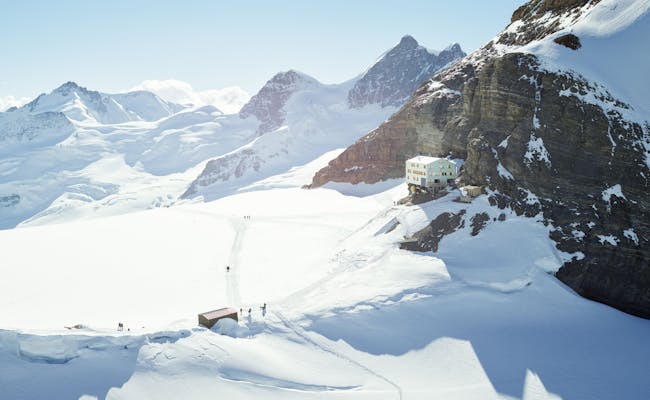 Mönchsjochhütte (Foto: Jungfraubahnen)
Mönchsjochhütte (Foto: Jungfraubahnen)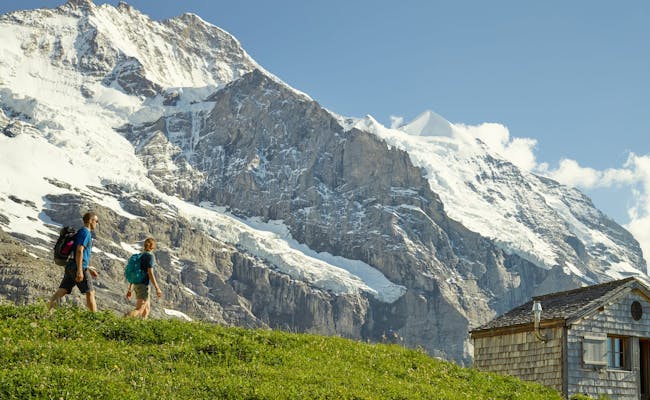 Mittellegihütte Eiger Walk (Foto: Jungfraubahnen)
Mittellegihütte Eiger Walk (Foto: Jungfraubahnen)Hike to the ice caves below the Jungfraujoch
The ice caves are located below the Jungfraujoch on the edge of the glacier. The entrances to the ice caves are accessible. Thus, the deep blue ice caves can also be hiked inside.
As a result of glacier recession, individual hiking trails had to be closed again and again in the past. Slopes started to slide because the pressure on the surrounding rock decreased. For this reason, the full-day hike should only be done with an authorized mountain guide and is also possible for school children.
Guided glacier hikes to the ice caves start in Moosfluh or from Bettmeralp. During the hike the glacier is always in view. For the start from Moosfluh, the approach begins in eastern Riederalp via the Riederalp - Moosfluh cable car. From Bettmeralp guided "Gletschertouren Katzenlöcher" to the ice caves are offered with the following schedule:
- 1,5 hrs. ascent to the Blausee - Biel
- 1,0 hrs. descent from the ridge down to the glacier
- 2,0 hrs. hike on the glacier
- 1,5 hrs. ascent from the cat holes up to the ridge
- 0,5 hrs. via Biel down to Bettmeralp
The best time for these hikes is from June to October.
 Eishöhle (Foto: Schweiz Tourismus MySwitzerland))
Eishöhle (Foto: Schweiz Tourismus MySwitzerland))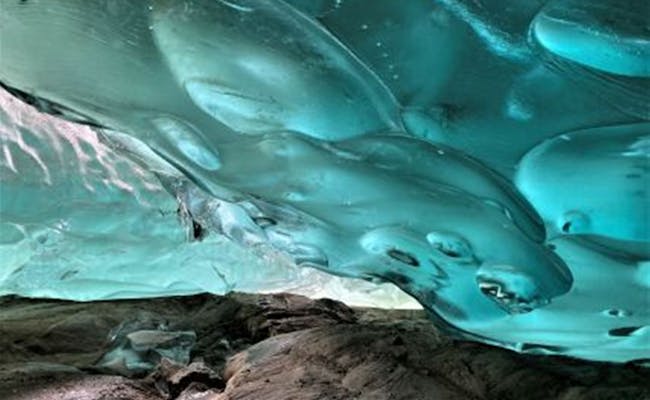 Eishöhle (Foto: Schweiz Tourismus MySwitzerland))
Eishöhle (Foto: Schweiz Tourismus MySwitzerland))Via ferrata at the Jungfraujoch
There are challenging via ferratas near the Jungfraujoch. Some sections may only be climbed in the company of a mountain guide. The via ferratas are secured by wire ropes, iron steps or wire ropes.
In addition to a good physical condition, the right equipment for the via ferratas is very important. This includes a climbing helmet, via ferrata set, climbing harness, webbing sling, via ferrata shoes, via ferrata gloves and HMS carabiners.
The German Alpine Association DAV gives ten recommendations for via ferrata.
The two most famous via ferratas in the region are (moderately difficult):
The via ferrata via Ferrata Aletsch includes climbing passages in the upper Massaschlucht. It leads around the Gibidum reservoir. The 80m long and 40m high Nepal Bridge is a particular challenge. Climbing experience is important on the steep rock faces of the Stockflüe, as there are several difficult traverses.
- 3,4 km length
- 4 hrs.
- 131 meters of ascent
- 142 meters of descent
The via ferrata Eggishorn requires in particular a head for heights and surefootedness. A 40-meter-long three-rope bridge and a 30-meter-long suspension bridge are the special features of this A further 30-meter-long tyrolienne (rope slide) may only be used in the company of a mountain guide. However, it can be bypassed.
- 1,4 km length
- 3 hrs.
- 145 meters of ascent
- 145 meters of altitude descent
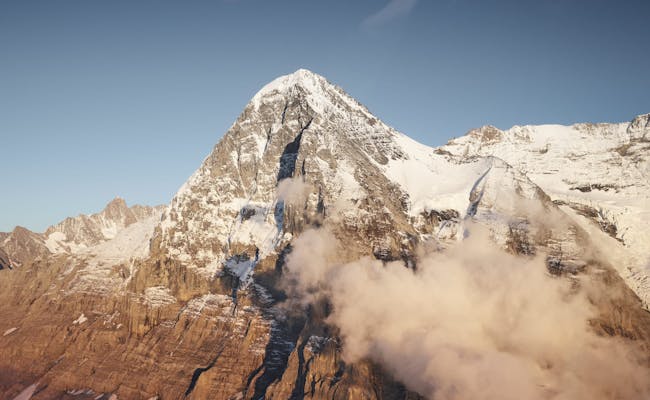 Eigernordwand (Foto: Jungfraubahnen)
Eigernordwand (Foto: Jungfraubahnen)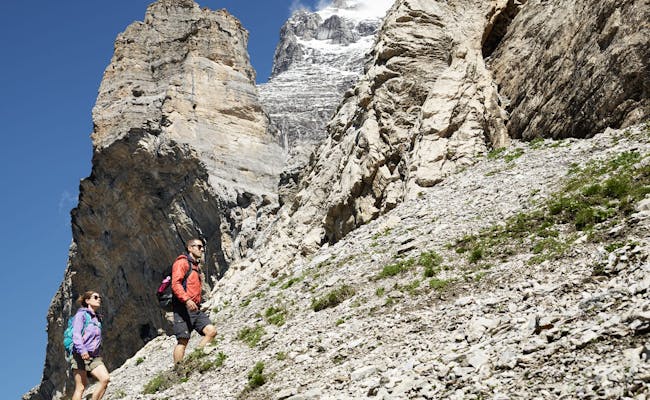 Eiger Sommer (Foto: Jungfraubahnen)
Eiger Sommer (Foto: Jungfraubahnen)Helicopter flight to the Jungfraujoch
Helicopter flights to the Jungfraujoch start, for example, at the Gsteigwiler heliport near Interlaken or at the Croix de Coeur altiport in Lauterbrunnen. During the flight, there is a direct view of the 4,158-meter-high Jungfrau mountain peak, as well as the Mönch and Eiger.
Disembarkation is either directly on the glacier or at the starting point. Without exit the helicopter flight lasts about twenty minutes, with exit thirty minutes.
Some helicopter flights combine the tour with the Matterhorn. They take about sixty minutes as a sightseeing flight, including glacier landing correspondingly longer.
45-minute sightseeing flights around the Jungfraujoch start from Bern-Belp airport. They lead along the Aare, over Lake Thun, past the north face of the Eiger to the Jungfraujoch. The return flight is along the Schilthorn over the area of Lauterbrunnen back to the starting point.
Flights with a helicopter to or around the Jungfraujoch usually take place with five passengers.
There are a few things to keep in mind:
- The maximum weight of all passengers
- Equipment and clothing adapted to the weather
- Camera and sunglasses
- Pregnant women after the 20th week, persons with pacemakers, physical and mental restrictions only after consultation with the doctor in charge
- Spontaneous deviations from the flight route are decided by the pilot.
 Helikopterflug Rundflug (Foto: Fun Flights)
Helikopterflug Rundflug (Foto: Fun Flights) Helikopterflug Rundflug (Foto: Fun Flights)
Helikopterflug Rundflug (Foto: Fun Flights)Snow Fun Park at Jungfraujoch with Tyrolienne
In addition to snow, the Snow Fun Park has another attraction to offer in summer: a zipline. It is called Flying Fox, Tyrolienne or Zipline and is open daily from the end of May to mid-October from 10:30 to 17:00.
Snowkiting at the Jungfraujoch
Snowkiting at the Jungfraujoch is carried out directly on the glacier. The prerequisites for this are appropriate snow and wind conditions. Trained snowkiters or beginners under professional guidance can snowkite at Schneefäld, for example.
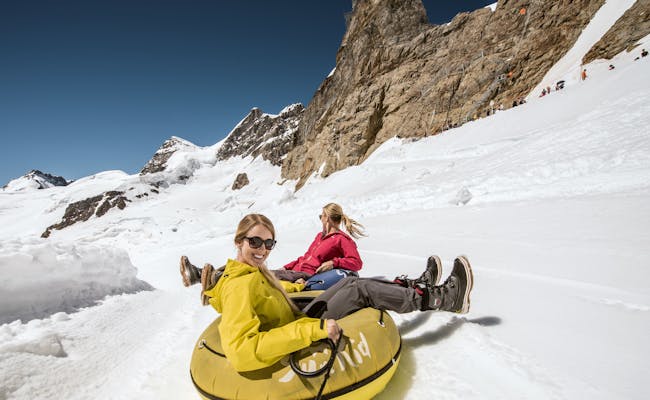 Snow Fun Park (Foto: Jungfraubahnen)
Snow Fun Park (Foto: Jungfraubahnen)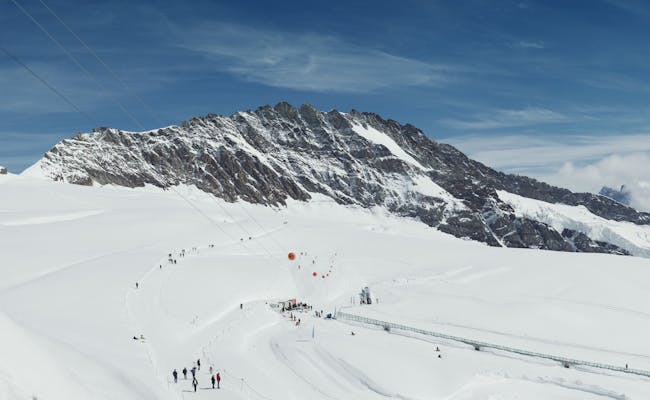 Snow Fun Park (Foto: Jungfraubahnen)
Snow Fun Park (Foto: Jungfraubahnen)Restaurants, bars and stores at the Jungfraujoch - Top of Europe
There are several restaurants and bars on the Jungfraujoch. They offer food and drinks as well as the view of snow, mountains and panorama.
Self-service restaurant Aletsch
The Aletsch self-service restaurant offers traditional Swiss dishes, Rugenbräu beer, a top-of-Europe wine and various non-alcoholic refreshments. It is open daily during the day 10:15 - 14:30.
Self-service restaurant Bollywood
The self-service Bollywood restaurant has Indian and Asian cuisine on the menu. It stands at 3,454 meters above sea level and offers a direct view of the glacial panorama of Europe's longest glacier. The self-service Speedy restaurant is located in the reception hall of the Top of Europe station on the first floor. It offers homemade cakes and sandwiches. Its motto is "simple, fast and uncomplicated". It opens weekdays during the day until about 15:00.
Restaurant Crystal
The à la carte Restaurant Crystal serves international and classic Swiss cuisine in a high alpine ambience. It also serves homemade desserts and homemade Eigerspitzli for coffee. Open daily from 11:00 am - 3:00 pm (weather permitting and in high demand).
Coffee Bar
The Coffee Bar welcomes travelers in the entrance hall of Jungfraujoch Station. In addition to drinks, it serves baked goods, snacks and handmade chocolate specialties. The Coffee Bar is open daily during the day at the operating hours of the railroad (in bad weather from 10:15 - 14:30).
Sphinx Bar
The Sphinx Bar is located on the Sphinx Rock, which is reached via an elevator. Next to the observatory, drinks such as beer, aperitifs or hot chocolate are served on the terrace. The bar is located 117 meters above the Jungfraujoch. Open from 11:30 to 14:00 in summer when the weather is nice
Speedy Restaurant
Homemade cakes and sandwiches are offered on the first floor of the Top of Europe. Open only in very nice weather and high demand, from 11:30 - 14:00.
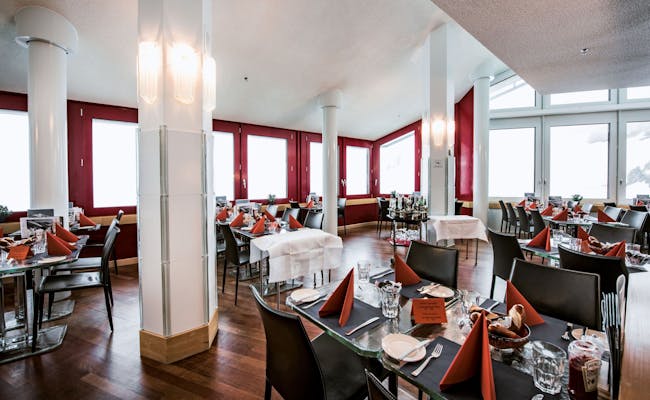 Restaurant Crystal (Foto: Jungfraubahnen)
Restaurant Crystal (Foto: Jungfraubahnen) Restaurant Aletsch (Foto: Jungfraubahnen)
Restaurant Aletsch (Foto: Jungfraubahnen)Top of Europe Flagship Store with Top of Europe Shops
The Top of Europe Shops are souvenir stores offering chocolate, watches or clothing directly on the Jungfraujoch. They form the center of the Top of Europe Flagship Store. Special decorations are designed to make shopping a pleasure.
These include the historic Eiger Ambassador Express right at the entrance, entire ceilings made of Swiss Army knives or silver leaves, and giant replica watch movements. Visitor guidance is provided by a replica train track that runs through the entire store.
In addition to useful items such as forgotten hats, warm clothing or sunscreen, visitors can also find valuable souvenirs such as Swiss Army knives, watches or perfumes. Customers have the opportunity to create their own Swatch with motifs from the Jungfrau region in the Swatch Store. It will be printed directly on site.
Lindt chocolate, luggage or carved wooden figures are offered as well as snow globes, magnets, key rings and other small souvenirs. In the Lindt store, visitors can directly experience the production of chocolate.
The Top of Europe Flagship Store extends over two floors and also contains a Jungfrau Railways competence center, the "Rail Info & Ticket".
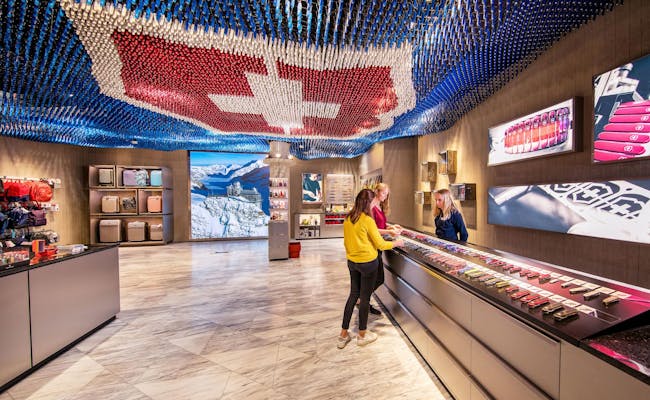 Top-of-Europe Flagship Store Victorino (Foto: Jungfraubahnen)
Top-of-Europe Flagship Store Victorino (Foto: Jungfraubahnen) Lindt Shop (Foto: Jungfraubahnen)
Lindt Shop (Foto: Jungfraubahnen)Weather at the Jungfraujoch
Even in summer, the weather changes quickly and should be checked in any case before a visit. Winter clothing is appropriate even in summer, plus headgear and sunscreen.
The weather at the Jungfraujoch in extreme climatic conditions
There is snow at the Jungfraujoch even in summer. At the same time, the sun shines in particular strength, as it is reflected by ice and snow. The weather can change very quickly on the Jungfraujoch, on the glacier and surrounding regions. Weather-appropriate clothing therefore means warm clothing (onion style), sun protection, sunglasses, gloves and warm headgear even in summer. On each excursion are also required especially slip and waterproof mountain boots.
Unpredictable weather on the glacier
The weather is often unpredictable in the Jungfrau region. The average annual temperature is about -8 degrees Celsius and even in summer only slightly above freezing. Extreme temperatures rarely reached are -37 and +18 degrees Celsius. Heavy icing and snowfall lead to increased avalanche danger. The average wind speed measured per year is about 25 km per hour, towards evening and at night gusts reach up to 60 km/h, mostly the wind blows from south-southeast. There is fog on the Jungfraujoch on about half of the days in the year.
 Berghaus Aletschgletscher (Foto: Jungfraubahnen)
Berghaus Aletschgletscher (Foto: Jungfraubahnen)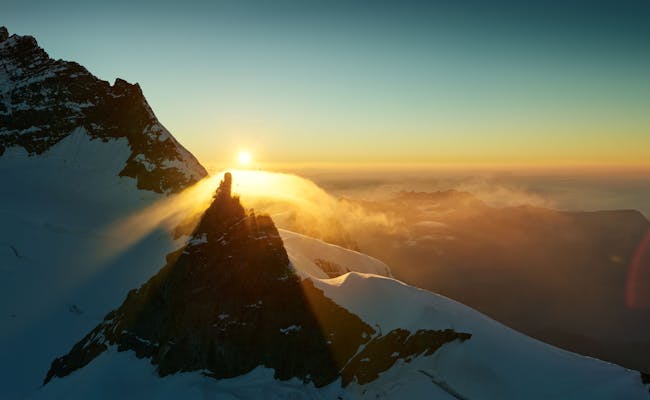 Sphinx Aussicht Sonnenuntergang (Foto: Jungfraubahnen)
Sphinx Aussicht Sonnenuntergang (Foto: Jungfraubahnen)Location and approach to the Jungfraujoch
The Jungfraujoch connects the four-thousand-meter peaks Jungfrau and Mönch. It is located directly on the border between the cantons of Bern and Valais.
On foot, access to the Jungfraujoch from the southern Valais via the Aletsch Glacier is possible as an easy trekking tour, but dangerous due to the danger of crevasses in the Jungfraufirn. An ascent from the Bernese Oberland represents an arduous high altitude tour that is only possible in favorable weather.
To the station of the Jungfrau Railway in Kleine Scheidegg, cogwheel trains of the Wengernalpbahn leave from Grindelwald as well as from Lauterbrunnen.
From Interlaken to Grindelwald (terminal), the drive takes just under half an hour. The approach is via the Grindelwaldstrasse.
Grindelwald Terminal is also reached in half an hour by Berner Oberland Bahn. Trains depart from Interlaken Ost every 30 minutes.
Parking in Grindelwald and Lauterbrunnen
Two large parking lots are available for visitors arriving by car. One is in Grindelwald Terminal, the other in Lauterbrunnen.
The parking garage in Lauterbrunnen is 2.50 m high inside and open throughout. Tickets can also be booked online. The Parkhaus in Grindelwald Terminal offers 1000 parking spaces and is also booked online. Entry and exit is via a QR code.
 Bahnhof Kleine Scheidegg (Foto: Jungfraubahnen)
Bahnhof Kleine Scheidegg (Foto: Jungfraubahnen) Parkhaus (Foto: Jungfraubahnen)
Parkhaus (Foto: Jungfraubahnen)12 tips for your first visit to the Jungfraujoch
The Jungfraujoch is nicknamed “The Top of Europe” for good reason.
Its associated Railway Station is indeed the highest in all of Europe, situated over 3400 m above sea level. As a saddle connecting two significant mountains of the Bernese Alps (Jungfrau and Mönch), it enjoys some of the most picturesque views Switzerland has to offer.
Combined with a modern infrastructure and additional sights below its observatory, the summit is the perfect destination for an exciting day trip. Below are our 12 best tips for your first trip to Jungfraujoch.
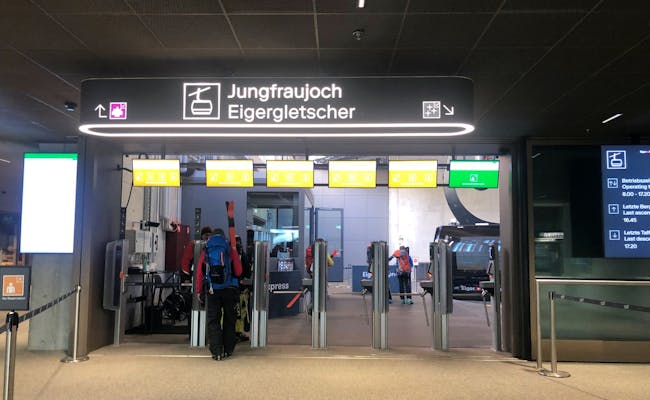 Station Eiger Express (Foto: Mathias Graf)
Station Eiger Express (Foto: Mathias Graf)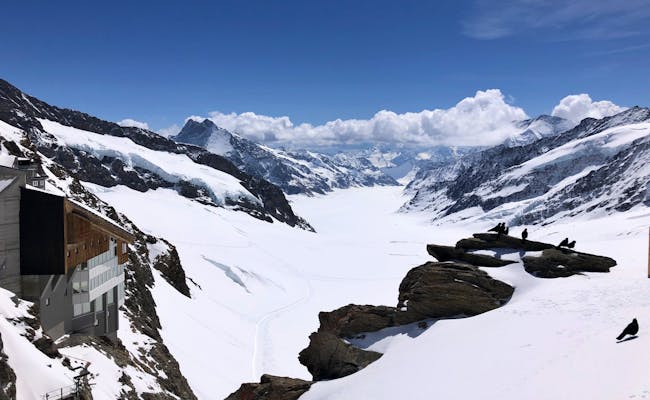 Jungfraujoch Aussichtsplattform (Foto: Seraina Zellweger)
Jungfraujoch Aussichtsplattform (Foto: Seraina Zellweger)Stay hydrated
While staying hydrated should be one of your daily priorities anyway, it becomes even more important when in high altitude. Lower oxygen concentration means that you will be breathing more frequently and thus increasing your heart rate.
On top of that, air in high altitudes holds less moisture than on the ground, which can be a contributing factor to dehydration. We have found it is easier to prevent a hydration-related headache than to cure it, so make sure to drink plenty of water.
WCs are available in large quantity
If you are worried about where to get rid of all the water you drank, we have good news. There are more than enough toilets. When nature calls, you'll be well taken care of on the way to and on the Jungfraujoch.
Toilets are everywhere, except in the trains. Since the route is partly very steep, the installation of a toilet in the train would not be without problems. But all stations, terminals, restaurants and even the middle station at the Eismeer offer enough possibilities for a short stopover.
Wear sun protection
The sun is very strong in high altitudes and can leave you with an unexpectedly red face. So make sure you come prepared with sunscreen and sunglasses.
Besides potentially complementing your chic mountain outfit, sunglasses are an essential part of any trip to the snow. The (over)exposure of UV rays reflecting from the white surface of the snow can result in a temporarily burned cornea.
Trust us when we say that looking into the snow while the sun is shining isn’t fun. So make sure you bring the strongest pair of sunglasses you can find. Your retina will thank you.
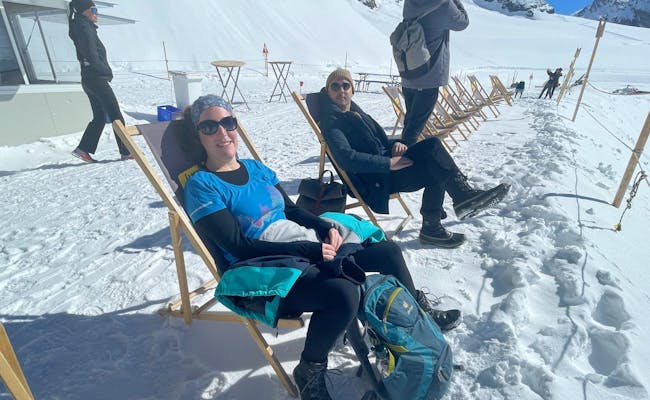 Sonnenschutz ist ein Muss auf dem Jungfraujoch
Sonnenschutz ist ein Muss auf dem Jungfraujoch Das Swiss Activities Team auf dem Jungfraujoch
Das Swiss Activities Team auf dem JungfraujochPut on warm clothes
Don't let the temperatures in Interlaken and the surrounding area fool you. Even if you decide to visit the Jungfraujoch in spring or later. After all, you are on a mountain top surrounded by snow and glaciers. So the temperatures can drop below zero all year round.
Also, be sure to wear sturdy shoes with a good sole. Especially if you decide to hike to the Mönchsjochhütte. Good footwear will not only keep you warm, but also prevent you from slipping on the icy ground.
Hike to the Mönchsjoch hut
From March to October you have the possibility to hike the beautiful trail from Jungfraujoch to Mönchsjochhütte. We recommend you take this hike to experience the snow and glaciers up close. However, make sure you don't leave the trail. You are surrounded by glaciers all the time, which can be potentially dangerous if you step on unsecured ice.
The hike from Jungfraujoch to Mönchsjochhütte takes about an hour - including breaks. If you're planning this tour, the other tips in this article will also help you. They are also helpful for the ascent to this higher hut.
On this great hike is just the right time to unpack your camera or cell phone and take pictures. The vast mountain landscape between the two mountains is the perfect backdrop for stunning photos.
If you want to grab a bite to eat at the Mönchsjochhütte, be sure to check the opening hours. Lunch is not served until 11:30 am. But you can also stop in before and enjoy a cup of coffee or tea. At the hut you can pay with cash, credit card or Twint.
 Wanderung zur Mönchsjochhütte (Foto: Mathias Graf)
Wanderung zur Mönchsjochhütte (Foto: Mathias Graf)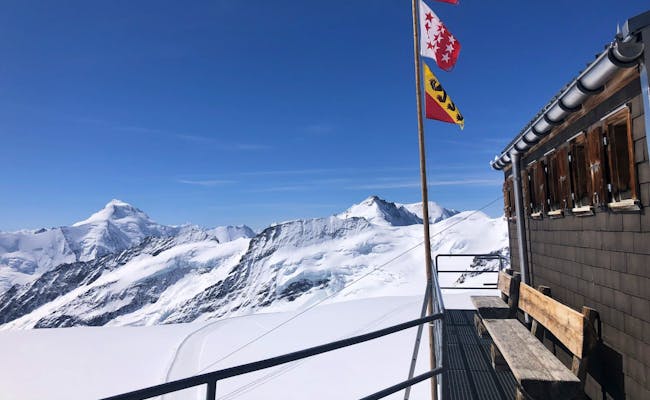 Mönchsjochhütte (Foto: Seraina Zellweger)
Mönchsjochhütte (Foto: Seraina Zellweger)Take time for other activities
There is plenty to see and do once you are at the Sphinx Observatory. So factor in enough time to experience all Jungfraujoch has to offer.
The publicly accessible viewpoint on top of the observatory provides you with stunning 360 degree views of the mountains and its surrounding towns. Need a break? Enjoy one of the typical Swiss meals in the restaurant, while being surrounded by the lush views.
Still got some energy left in the tank? Head down to learn more about the history of the Jungfraujoch and how it was built or visit the Eispalast, a cave-like structure made entirely out of ice. The latter features ice sculptures made by various artists.
We recommend at least 4 hours if you plan on hiking to Mönchsjoch Hut and having lunch at Jungfraujoch. If it's a busy day, try and make it even more to ensure you’re not in a rush.
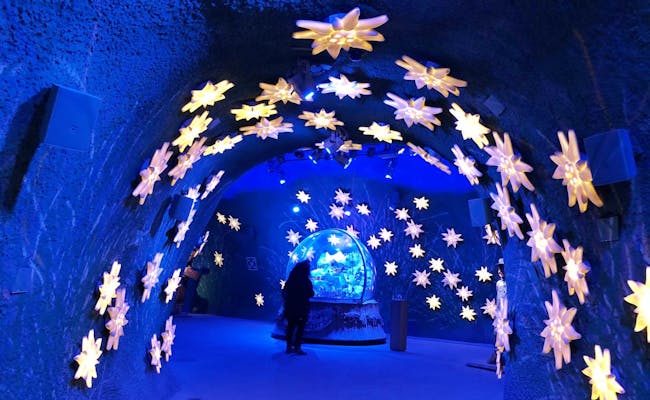 Jungfraujoch Erlebniswelt
Jungfraujoch Erlebniswelt Im Eispalast (Foto: Leon Amrein)
Im Eispalast (Foto: Leon Amrein)Bring your best camera
As you might have guessed, the trip to the Jungfraujoch is made for capturing beautiful memories with your phone or camera. The vegetation and surroundings vary greatly between Interlaken and the top of the mountain. So you have more than enough opportunities for breathtaking shots.
If you take the cable car on the way back to Grindelwald, we recommend you to sit in the direction of travel. Here you will be rewarded with a fantastic view of the valley.
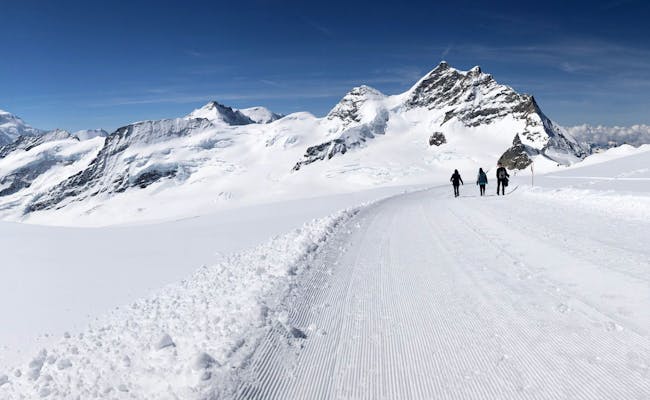 Wanderweg zur Mönchsjochhütte (Foto: Seraina Zellweger)
Wanderweg zur Mönchsjochhütte (Foto: Seraina Zellweger) Schnee und Berge, soweit das Auge reicht...
Schnee und Berge, soweit das Auge reicht...Take advantage of the stopovers
On the way to and from Jungfraujoch you will change trains several times. This moment is every time a fantastic opportunity to take more beautiful photos.
We especially liked the Kleine Scheidegg, the Eiger Glacier and the Sea of Ice. The latter is a short stopover between Kleine Scheidegg and the Jungfraujoch, where you have the opportunity to get off the train for a few minutes.
Don't miss this stop and experience the glacier up close through the large panoramic windows. The Jungfrau Railways staff will make sure that no one gets left behind during this short stop.
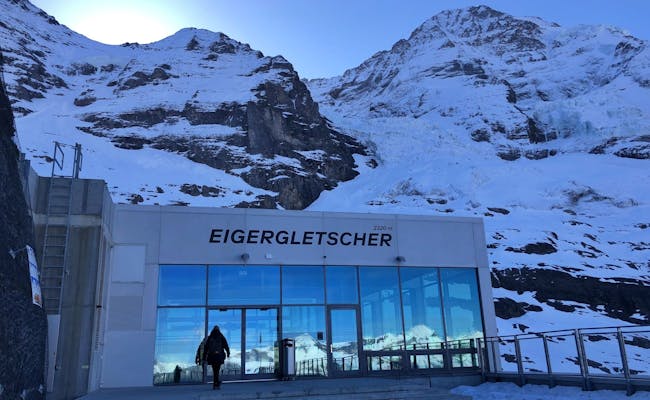 Zwischenstation Eigergletscher (Foto: Seraina Zellweger)
Zwischenstation Eigergletscher (Foto: Seraina Zellweger)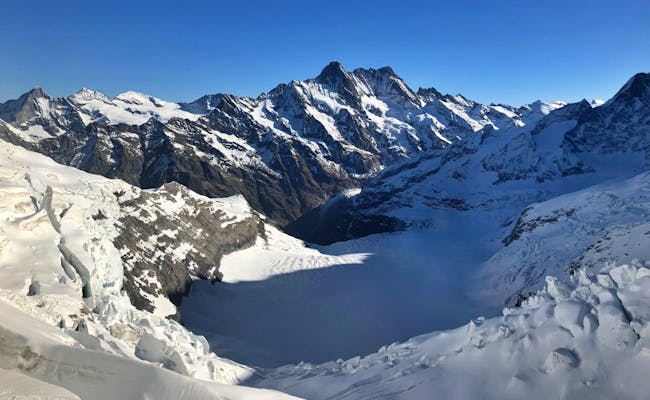 Zwischenstation Eismeer (Foto: Seraina Zellweger)
Zwischenstation Eismeer (Foto: Seraina Zellweger)Pick the right food to bring up
The difference in air pressure can also affect other parts of your trip besides your ability to breathe. As such, we don’t recommend bringing any liquid, sealed food items like yogurts with you. Higher air pressure might result in an unwanted explosion in your bag, potentially ruining the adventure before it has even begun.
We’ve seen it all…
Bring variety into your trip
From Interlaken you have two options to get to the Jungfraujoch. One route is via Grindelwald, the other via Lauterbrunnen. To enjoy all the views this spectacular journey has to offer, we recommend going up one way and down the other.
If you travel via Grindelwald, you'll see the mighty Eiger North Face up close. Via Lauterbrunnen, on the other hand, you will pass by Wengen and can see the world famous downhill of the Lauberhorn ski race.
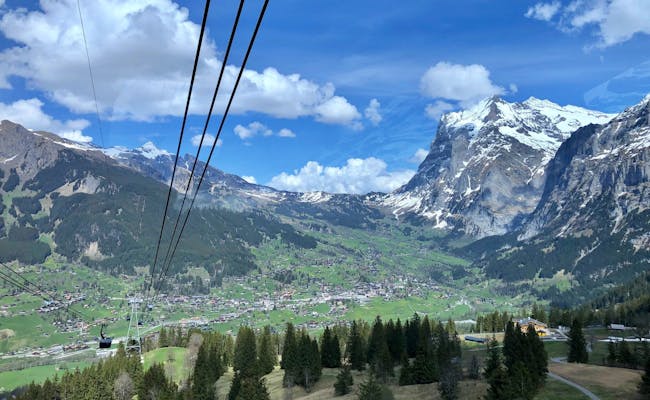 Eiger Express (Foto: Dennis Josek)
Eiger Express (Foto: Dennis Josek)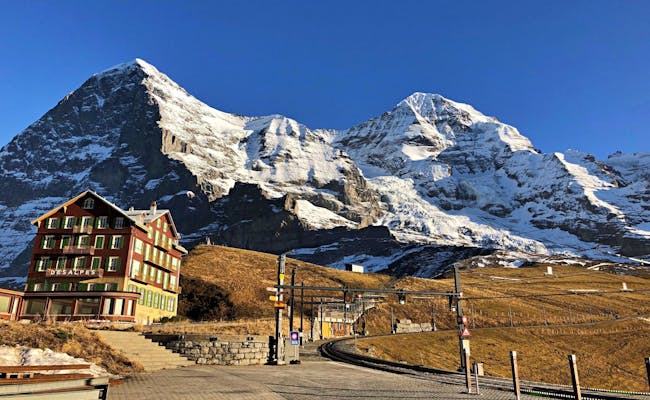 Kleine Scheidegg (Foto: Seraina Zellweger)
Kleine Scheidegg (Foto: Seraina Zellweger)Get on the right train from Interlaken
The train from Interlaken is split in Zweilütschinen. One half goes to Lauterbrunnen, while the other goes to Grindelwald. If you accidentally end up on the wrong part of the train, you will have a short time to change trains in Zweilütschinen.
However, to save yourself the additional stress, it is best to check in Interlaken that you are on the right train. If in doubt, ask the train staff at the station. They will be happy to confirm where you need to board.
Reserve your seat
This is probably the most important tip of all during high season. It gets ridiculously busy at times. You’d hate to waste your precious time waiting in line instead of enjoying the view at the Top of Europe. So make sure you have your seat reservation ready and feel like a royal while you pass all the people queuing up in hope of a free seat.
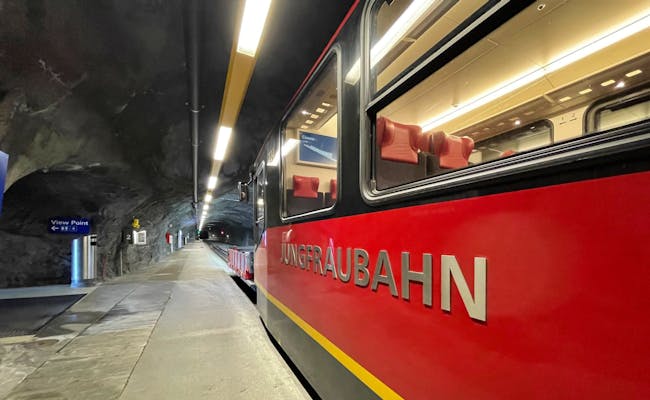 Jungfraubahn (Foto: Mathias Graf)
Jungfraubahn (Foto: Mathias Graf)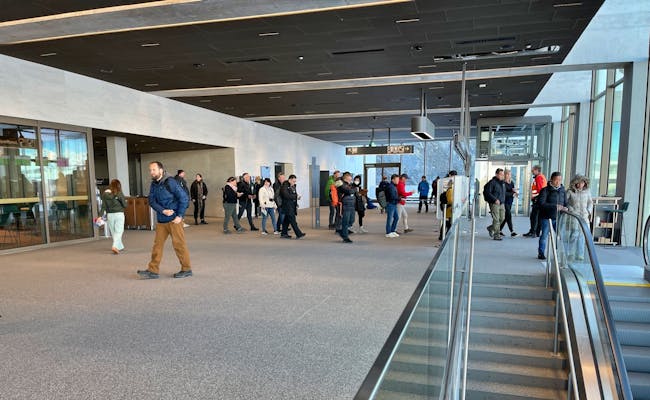 Zwischenterminal Eiger Express (Foto: Mathias Graf)
Zwischenterminal Eiger Express (Foto: Mathias Graf)
